Mexico 2023 "Prehistoric Dimensions"
| <prev | back to index | next> |
| Issue Date | 17.07.2023 |
| ID | Michel: 4364-4366; Scott: 3299a-c. 3299d; Stanley Gibbons: ; Yvert et Tellier: 3404-3406; Category: pR |
| Design | Victor Slehiman, Nancy Torres Lopez |
| Stamps in set | 3 |
| Value |
$15.00 - Coahuilaceratops magnacuerna $15.00 - Aquilolamna milarcae $15.00 - Acantholipan gonzalezi |
| Emission/Type | commemorative |
| Issue place | Mexico City |
| Size (width x height) | stamps: 48 mm x 40 mm strip of 3: 144 mm x 40 mm |
| Layout | Mini-Sheet of 3 stamps (limited edition), Sheet of 24 stamps (8 strips of 3 stamps, 2 strips a row) |
| Products | FDC x1; FDS x1; numbered Mini-Sheets |
| Paper | Glossy white couché, rubberized 110 g/m2 |
| Perforation | 13 x 13 |
| Print Technique | Rotogravure, multicolor |
| Printed by | Talleres de Impresión de Estampillas y Valores, Mexico |
| Quantity | stamps: 300.000 (100.000 strips), First Day Sheet (FDS): 1.300, Mini-Sheets: |
| Issuing Authority | Correos de Mexico |
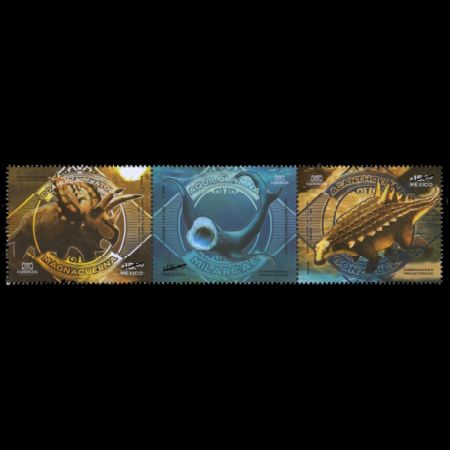
On July 28st, 2023, the Mexican Postal Service company also known as Sepomex, issued the set of 3 stamps "Prehistoric Dimensions".
These stamps were issued in cooperation with the Desert Museum of Saltillos, Coahuila. Fossils of all three prehistoric animals, two dinosaurs: Coahuilaceratops, Acantholipan and a shark Aquilolamna were discovered in the desert and are in the Museum's collection. This is the second stamps set with prehistoric animals, issued by the Mexican Postal Service company in cooperation with the Desert Museum. The previous stamps set, "Dinosaurs of Mexico" was issued in 2006.
The Desert Museum is a museum in Saltillo (850km away from Mexico City), Coahuila, that promotes an ecological culture by showing the wealth of life and the evolution of species, including many fossils through time in an interactive way.
The Chihuahuan Desert is a desert ecoregion designation covering parts of northern Mexico and the southwestern United States. It occupies much of far West Texas, the middle to lower Rio Grande Valley and the lower Pecos Valley in New Mexico, and a portion of south-eastern Arizona, as well as the central and northern portions of the Mexican Plateau.
The Museum was designed by the architect Francisco López Guerra and was inaugurated on 25 November 1999.The museum is divided into four main pavilions with different themes:
- "The desert and its past"
- "Man and the desert: A space of meetings"
- "Evolution and biodiversity"
- "The laboratory of life"
"Evolution and biodiversity is dedicated to the evolution of life in the area over the past 12,000 years. During this time frame, the region was home to mammoths, saber-toothed cats, short-faced bears, and gomphotheres."
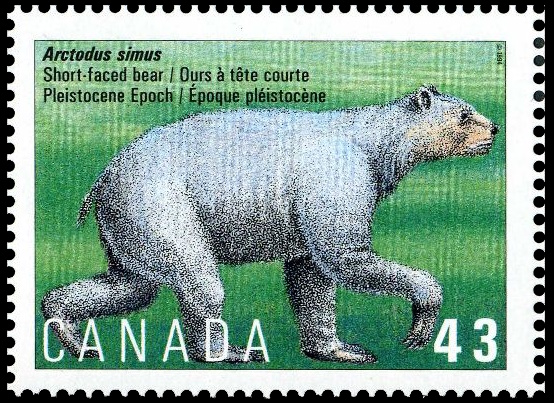 |
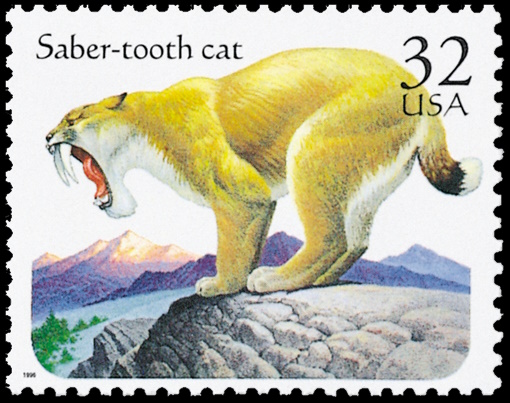 |
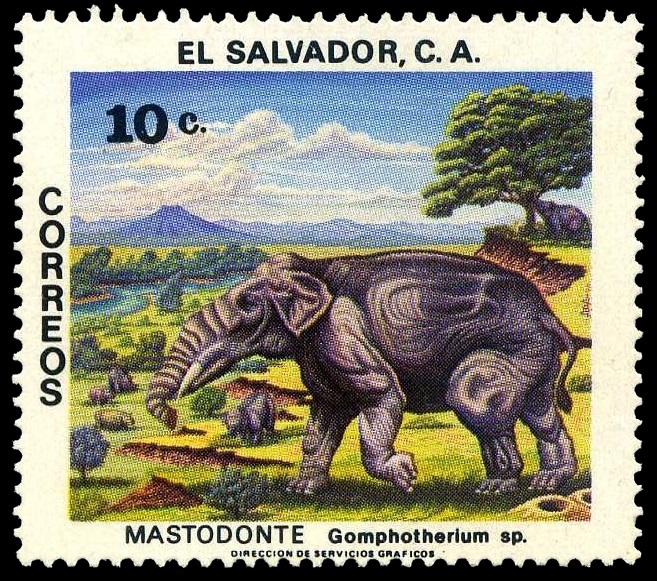 |
|
Short-faced bear on stamp of Canada 1994, MiNr.: 1448, Scott: 1531. |
Saber-toothed cat on stamp of USA 1996, MiNr.: 1289, Scott: 911. |
Gomphotheres on stamp of El Salvador 1979, MiNr.: 2738, Scott: 3080. |
Luis Gómez Sánchez, the President of the Board of Directors of the Desert Museum, explained these stamps were issued to represent more than 20 years of paleontological research and collaboration by the museum. Through them, the message of conservation will be reflected in history and will become pieces highly valued by collectors and philately enthusiasts.
He stated that nowadays is a very important moment for the development of all Mexican paleontology due to the extraordinary findings in Mexico, with dinosaurs of new genera and new species that have been discovered.
We are doing a whole process of conservation of Mexican paleontology to be able to perfectly identify those fossils to conserve them and make them known to the world through the postage stamps issued in coordination with the Mexican Postal Service.
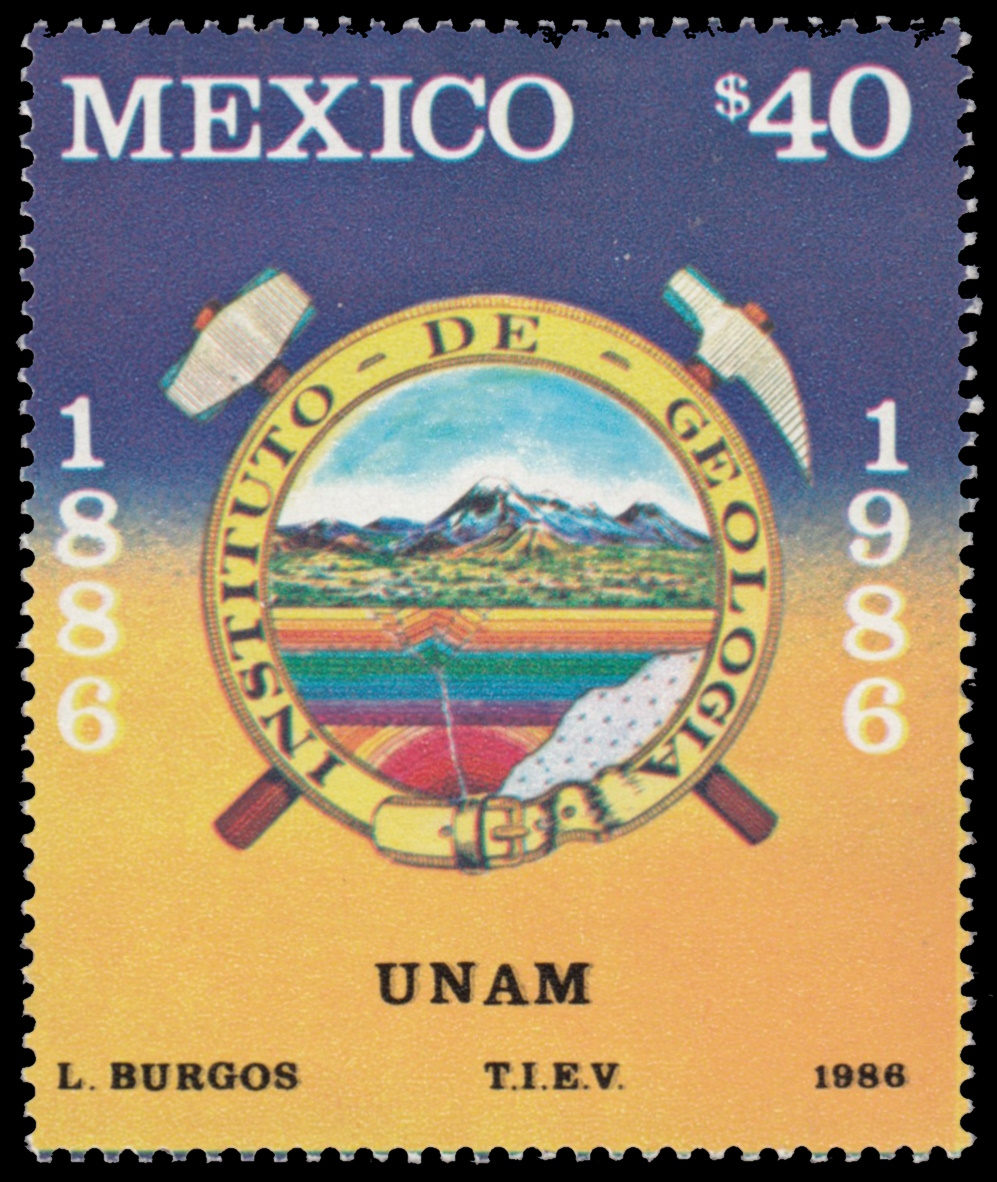 |
| Centenary of establishment of the Instituto Geológico Nacional (IGN) of Mexico, MiNr.: 1984, Scott: 1436 |
The first records of discoveries of prehistoric gigantic bones in
what is today Mexico begins with the mythology of pre-Hispanic Aztecs.
The first documented report about dinosaur's footprints were
made in 1867 by French geologists M. M. Dollfus and E. de Montserrat.
The foundation of the Mexican Geological Commission in 1886 and two years later,
the Instituto Geológico Nacional (IGN), provided a solid substratum for
geological and paleontological studies in Mexico.
The first paleontological collection of the Institutional Museum was established
by José Guadalupe Aguilera, and for that reason, he is considered the father
of Paleontology in Mexico.
However, even when earlier paleontological studies in Mexico include diverse fossil
groups, most of the paleontological studies were published by foreign scientists
until the beginning of the 1990s.
The systematic paleontological research in Mexico began after foundation of
the Mexican Paleontologic Society (Sociedad Mexicana de Paleontología - SOMEXPAL)
in 1986, as result of raise public interest on paleontology based on several discoveries
at that time.
Nowadays it is the most important professional paleontological association in Mexico
that agglutinates a large number of specialists in the country with research lines
that include in order of published works:
invertebrate paleontology, vertebrate paleontology, micropaleontology,
paleobotany and paleobiological studies.
The postage stamps issued by each nation have that important mission, to be cultural ambassadors of their countries working in favor of culture, in Correos de México we are passionate about thinking that, through a postage stamp, these fascinating species will travel our territory and 191 more countries than those that are part of the Universal Postal Union.
The title of the stamps set "Dimensiones Prehistoricas" (in English Prehistoric Dimensions) is the same as the temporary exhibition organized by the Desert Museum. The Museum, displayed fossils and replicas of prehistoric animals in one of the most iconic places of the Mexico City: The Los Pinos Cultural Complex, between June 10th and October 8th 2023.
Some media called the exhibition "Dinos en Los Pinos" (in English: Dinosaurs in Los Pinos) This exhibition was the result of joint efforts of the Foreign Ministry with the Museum of the Desert of Coahuila and the Federal Ministry of Culture.
These stamps were presented to the public on July 28th, 2023, in the Los Pinos Cultural Complex.
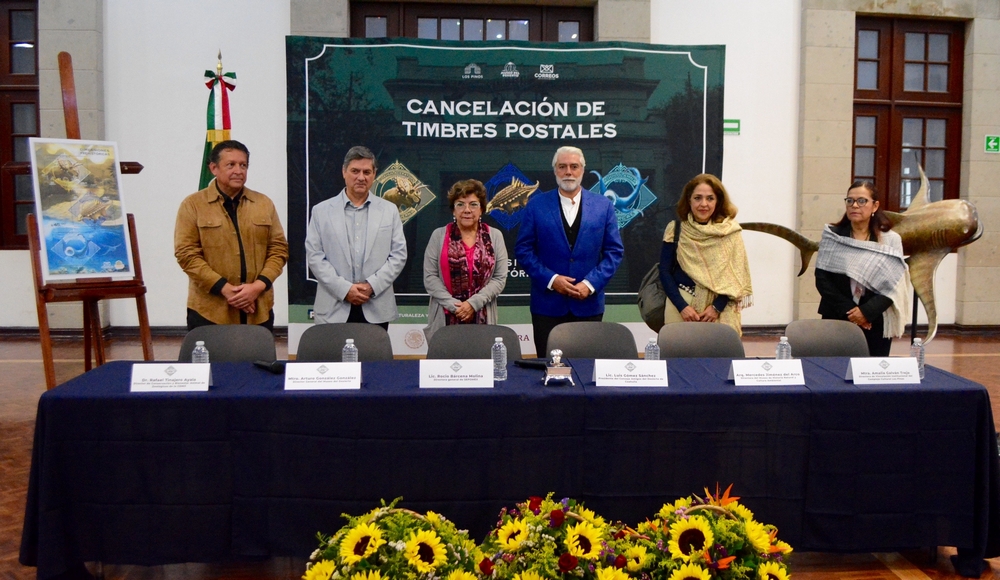
- Dr. Rafael Tinajero Ayala (Director of Conservation and Animal Welfare of Zoos of Mexico City)
- Mr. Arturo González González (Director General del Museo del Desierto)
- Mrs. Rocio Barcena Molina (The General Director of SEPOMEX, the Mexican Postal Service company)
- Mr. Luis Gomez Saches (The President of the Board of Directors of the Desert Museum)
- Mrs. Amalia Galván Trejo (Director of Institutional Liaison of the Los Pinos Cultural Complex)
- Ms. Mercedes Jiménez del Arco (Director of the Museum of Natural History and Environmental Culture of Mexico City)
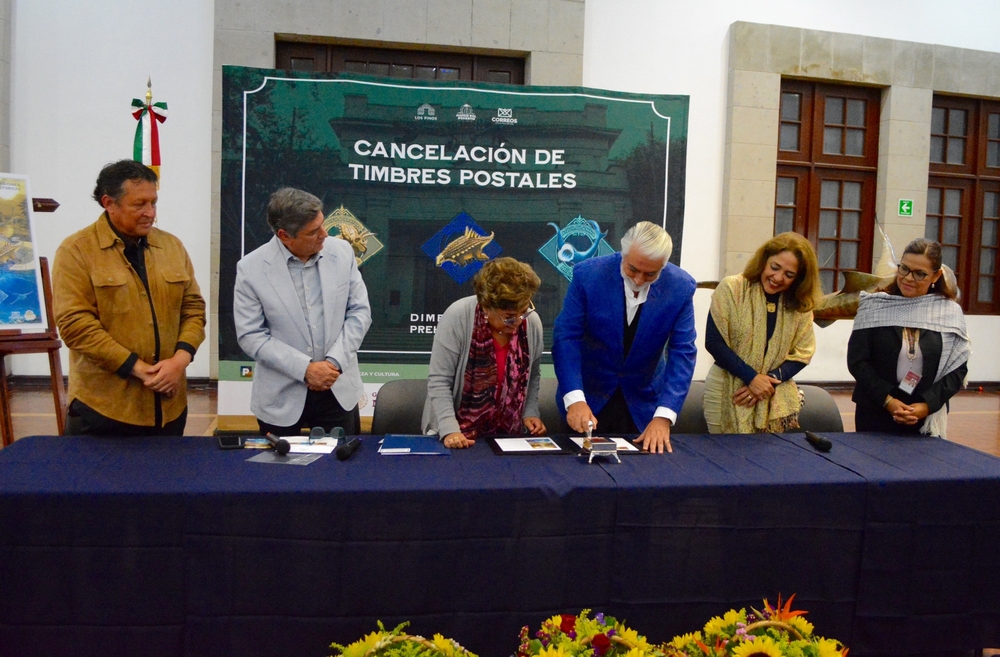
The reverse side of the official First Day Sheet contains the following text, written by Arturo González González and José Manuel Padilla Gutiérrez
Dinosaurs have been one of the most successful animal groups on
earth, as evolution terms and fame.
They have been central characters in movies, science fiction novels,
fairy tales, legends and all kinds of cartoons.
These majestic organisms have stimulated the imagination of children, adults,
scientists, writers and filmmakers.
Incredibly, in each stratum of fine sediments that were deposited one by
one in depths of ancient seas and coastal territories, today's well-known
Chihuahuan Desert, contain stories of a gigantic book that include past
diversity knowledge.
They are proof of the events that occurred in these territories,
which are expressed through the remains and evidence of different
organisms that were trapped for millions of years between these substrates.
With a history of more than 165 million years, they occupied practically all
available habitats on the continents of their geological time.
Their paleodiversity reached significant levels within the continental and
marine vertebrates, in this way specialists estimate that they produced more
than 1,500 species.
The dinosaur research now developing in Mexico have had a better understanding
of the environments that existed in Southern North America 70 million years ago.
Currently, The Chihuahuan Desert is the area with the largest range of dinosaur
fossils within the national territory.
This is due to the peculiar location of this territory 70 million years ago,
a time when there was a system of rushing mouth rivers in this area, which in
turn caused the development of marshes, lagoons and marshes.
As the States of Tabasco and Veracruz are today.
The exhibition, was distributed in 6 sections (dimensions), shows life-size reconstructions of prehistoric animal that inhabited the Earth over millions of years supported with museographic elements that allow visitors to appreciate the natural history of our planet as a true work of art and that allow to generate awareness for the conservation of our environment.
Fossils and reconstructions of all three prehistoric animals depicted on the stamps were on show in the exhibition.
The following prehistoric animals were depicted on the stamps:
Coahuilaceratops magnacuerna is a species of herbivorous ceratopsian dinosaur.
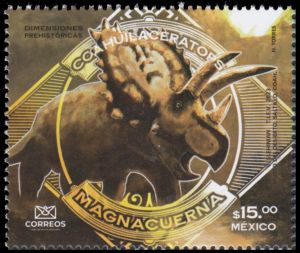 |
| Coahuilaceratops on stamp of Mexico 2023 |
The second part of the name, “ceratops,” is Greek for “horned face.”
The specific name magnacuerna combines the Latin word “magna,” meaning “great,” with the Spanish “cuerna,” meaning “horn,” in reference to the very large supraorbital horncores of this taxon.
Fossils of the dinosaur were discovered in 2001 by school teacher and amateur paleontologist Claudio de Leon Davila. De Leon Davila discovered the bones while looking for fossils in the Cerro del Pueblo Formation in the Ejido Porvenir de Jalpa, General Cepeda, Coahuila.
In 2003 the team from the Utah Museum of Natural History (USA), the Royal Tyrrell Museum of Palaeontology (Canada) and the Desert Museum (Mexico), uncovered fossils of two Coahuilaceratops specimens - one adult and a juvenile, as well as fish, turtles, crocodiles, lizard, snakes, and mosasaurs, together with dinosaur eggshells and abundant trackways.
The fossils of Coahuilaceratops were prepared at the Utah Museum of Natural History, requiring two years of meticulous work by skilled volunteer preparator Jerry Golden.
The dinosaur was formally described in 2010 by the team of international scientists led by Mark A. Loewen from the Utah Museum of Natural History (USA). It was the first horned dinosaur from Mexico and one of the first dinosaurs from the country to be named. In one of his interviews Mark Loewen said: "We know very little about the dinosaurs of Mexico, and this find increases immeasurably our knowledge of the dinosaurs living in Mexico during the Late Cretaceous"
Although based on incomplete remains, Coahuilaceratops is thought to possess among the largest horns of any dinosaur currently known. The supraorbital horns are about a meter long, the biggest known so far for a ceratopsian, and the skull is estimated to have been about 1.8 m long.
Even though such horns are common features of ceratopsid dinosaurs, those of Coahuilaceratops appear to be the largest known for the group, exceeding the size of eye horns even in Triceratops. Like other horned dinosaurs, Coahuilaceratops probably used its headgear to attract mates and fight with rivals of the same species.
Coahuilaceratops specimens are permanently housed in the collections of the Museum of the Desert. Casts of the fossils are available in the collections of the Utah Museum of Natural History in Salt Lake City (USA).
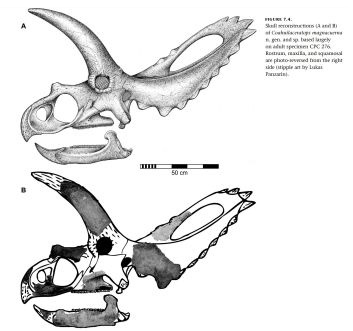 |

|
|
Skull reconstructions.
In the lower image, the darker colored elements of the skull represent the fossils found. Image credit: (Loewen 2010) |
Life restoration of Coahuilaceratops. Image credit: Wikimedia, Author: Gustavo Monroy-Becerril. |
Coahuilaceratops, a rhino-sized creature, has an approximate length of 6.7 meters and weighed between 4 and 5 tons.
Mark Loewen described the arid, desert terrain where the dinosaur was recovered as nothing like Mexico during the Late Cretaceous. About 72 million years ago, the region was a humid estuary with lush vegetation, an area where salt water from the ocean mixed with fresh water from rivers, much like the modern Gulf Coast of the south-eastern United States. Many dinosaur bones in the area are covered with fossilized snails and marine clams, indicating that the dinosaurs inhabited environments adjacent to the seashore.
The rocks in which Coahuilaceratops was found also contain large fossil deposits of jumbled duck-bill dinosaur skeletons. These sites appear to represent mass death events, perhaps associated with storms such as hurricanes that occur in the region today.
Aquilolamna is an extinct genus of shark-like elasmobranch from the Late Cretaceous (Turonian)-aged Agua Nueva Formation of Mexico.
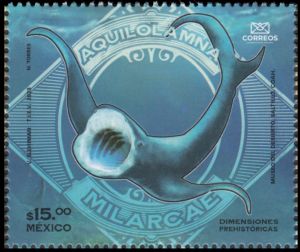 |
| Aquilolamna milarcae on stamp of Mexico 2023 |
The 93 million year old fossil was described from a single extremely well-preserved specimen, containing a fully-preserved skeleton and potential skin impressions, recovered in 2012 by an unknown quarry worker in Vallecillo in the Mexican state of Nuevo Leon. The specimen came to the attention of local teacher Margarito González González, who collected and prepared the specimen.
Over the coming years, it received increasing attention at paleontological conferences, and was finally described in 2021 by a European-Mexican paleontological team, including Dr. Romain Vullo from University Rennes in France and Prof. Dr Wolfgang Stinnesbeck from Heidelberg University in Germany.
Other scientists involved, besides Prof. Stinnesbeck and his team, were from the universities of Rennes (France) and Bonn, the Jura Museum Eichstätt of the Bavarian Natural History Collections, the State Museum of Natural History Karlsruhe and the Museo del Desierto in Mexico. The project was funded by the German Research Foundation. The results were published in the journal “Science”.
Dr. Vullo explained:
"The complete specimen was found in 2012 in Vallecillo, Mexico, a locality yielding
remarkably preserved fossils.
This site, already famous for its many fossils of ammonites, bony fish and other
marine reptiles, is most useful for documenting the evolution of oceanic animals.
My first thoughts on seeing the fossil were that this unique morphology is
totally new and unknown among sharks.
Standing out among both living and fossil planktivorous (plankton-eating) sharks
and rays, Aquilolamna milarcae resides somewhere in-between."
Aquilolamna displays an array of extremely unusual adaptations that make it unlike any living or extinct species of shark.
It had a torpedo-shaped body and tail similar to that of most sharks, but also had a pair of extremely long, winglike pectoral fins. These fins with width 1.90 meters from tip to tip were wider than it was long - 1.65 meters.
Another notable feature of Aquilolamna is its apparent lack of dorsal and pelvic fins. These, combined with its broad head, have led to the hypothesis that Aquilolamna was a planktivorous filter-feeder, similar to manta rays.
Even though this fish likely fed by sifting plankton or other small morsels from the water column, it may have had tiny, pointed teeth similar to modern filter-feeding sharks such as the basking shark and megamouth. These teeth can be used to determine the evolutionary relationships of these sharks, but none were found to date.
Unlike manta rays, which "fly" through the water by flapping their fins, Aquilolamna may have instead steadily "glided", slowly, through the water with the help of its slender pectoral fins, and propelled itself with its tail.
Acantholipan gonzalezi is a species of ankylosaurian dinosaur (Nodosauridae family) from Mexico from the early Santonian age of the Late Cretaceous. Acantholipan gonzalezi is on the logo of the Desert Museum, and was also selected as the motif for the First-Day-of-Issue Postmark.
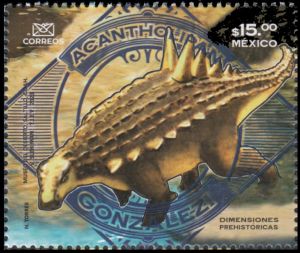 |
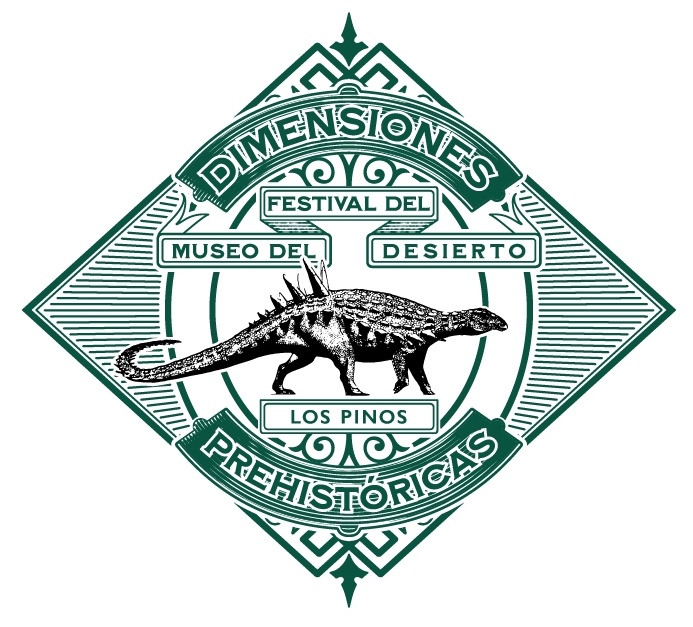 |
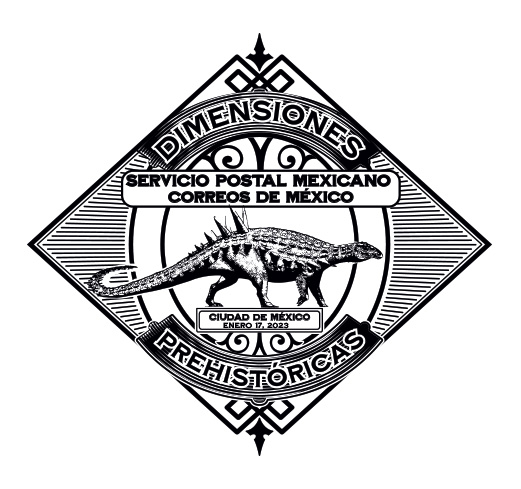 |
| Acantholipan gonzalezi on stamp of Mexico 2023 | Acantholipan gonzalezi on the Logo the temporary exhibition "Dimensiones Prehistoricas Dinos en Los Pinos" in the Desert Museum | Acantholipan gonzalezi on the draft First-Day-of-Issue Postmark of "Prehistoric Dimensions". In the final version the text was moved out of the image. |
Isolated bones and osteoderms of ankylosaurian dinosaurs were discovered from Late Cretaceous sediments of northern Coahuila, northeastern Mexico. They have been identified as remains of nodosaurids and were described and named in 2011. It seems to be a juvenile because of its measurements. It's 3.5 metres long and weighs more than half a ton.
The generic name combines the Greek akanthos, "spine", with lipan, the usual Spanish designation of the Lépai-Ndé, the "Gray People", a tribe of the Apache inhabiting the area where the fossils were found.
The specific name honours the Mexican paleontologist Arturo Homero González-González, the chairman of the Desert Museum (Museo del Desierto at Saltillo). Acantholipan gonzalezi is the first named ankylosaur from Mexico.
The dinosaur lived 85 million years ago, making it the oldest dinosaur to have inhabited the region. A replica of the prehistoric animal is on display at the museum which also features the most important collection of dinosaur bones, including the one we all know, the Tyrannosaurus Rex.
Products and associated philatelic items
| FDC | First-Day-of-Issue Postmark | Souvenir Sheet |
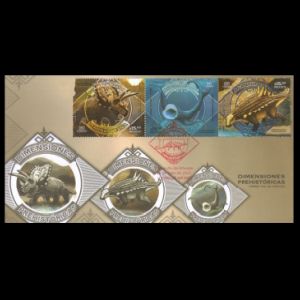 |
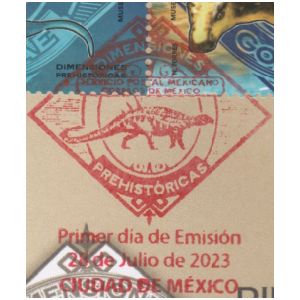 |
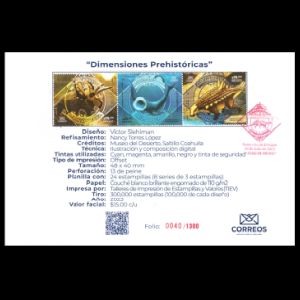 |
| The reverse side is here | ||
| Stamps Sheet | Mini-Sheet | Example of circulated cover |
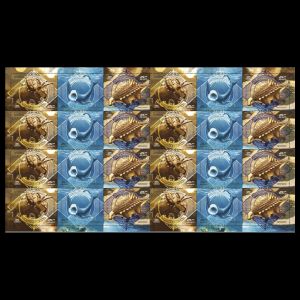 |
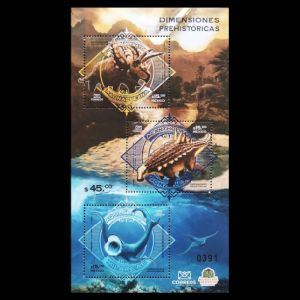 |
 |
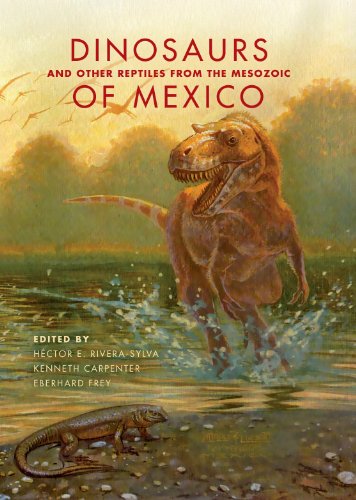
|
|
Dinosaurs and Other Reptiles from the Mesozoic of Mexico, by Héctor E. Rivera-Sylva and Kenneth Carpenter. Amazon: USA, UK, DE |
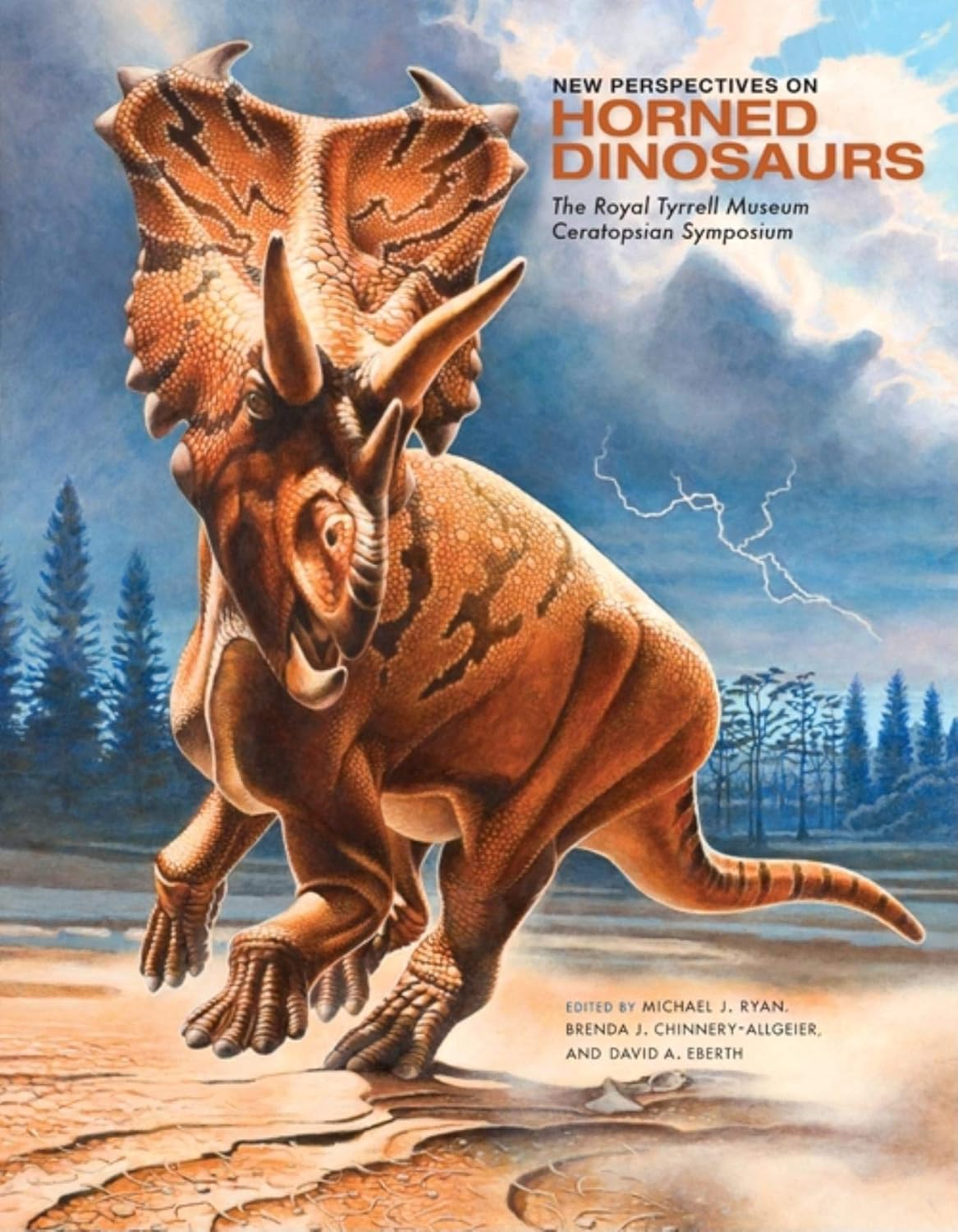
|
|
New Perspectives on Horned Dinosaurs: The Royal Tyrrell Museum Ceratopsian Symposium (Life of the Past), by Nicholas Longrich. Amazon: USA UK DE |
References
- Technical details and short description of the stamps:
- Government of Mexico (Gobierni de Mexico)
- Official First Day Sheet
- Stamps presentation ceremony (the Government of Mexico):
- The "Dimensiones Prehistoricas Dinos en Los Pinos" exhibition:
- Official website of the exhibition
- Time of Mexico
- Players of Life
- Milenio
- Chihuahuan Desert: Wikipedia.
- The Desert Museum:
- Paleontology in Mexico:
- Coahuilaceratops:
- Wikipedia
- Natural History Museum of Utah
- NBC News
- Horned dinosaurs (Ornithischia: Ceratopsidae) from the Upper Cretaceous (Campanian) Cerro del Pueblo Formation, Coahuila, Mexico, by Mark A. Loewen, Scott D. Sampson, Eric Lund, A.A. Farke.
- Acantholipan:
- Aquilolamna:
- Sci News
- Science
- Wikipedia
- National Geographic: (in English), (in German)
- University Heidelberg
Additional YouTube videos:

|
Acknowledgements
- Many thanks to Dr. Hector E. Rivera Sylva, curator of the Museo Del Desierto in Coahuila, Mexico, the co-author of "Dinosaurs and Other Reptiles from the Mesozoic of Mexico" book, for reviewing the draft page and his valuable comments.
- Many thanks to Dr. Peter Voice from Department of Geological and Environmental Sciences, Western Michigan University, for reviewing the draft page and his valuable comments.
| <prev | back to index | next> |